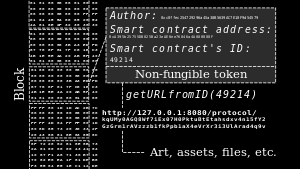NFT vs. DeFi: Understanding the Key Differences
In the rapidly evolving landscape of blockchain technology, two terms that have gained significant attention are Non-Fungible Tokens (NFTs) and Decentralized Finance (DeFi). While both NFTs and DeFi are innovative applications of blockchain, they serve distinct purposes and have unique characteristics. Understanding the differences between NFTs and DeFi is essential for investors, developers, and enthusiasts alike.
What are NFTs?
A non-fungible token (NFT) is a unique digital identifier that is recorded on a blockchain and is used to certify ownership and authenticity. It cannot be copied, substituted, or subdivided.[1] The ownership of an NFT is recorded in the blockchain and can be transferred by the owner, allowing NFTs to be sold and traded. NFTs can be created by anybody and require few or no coding skills to create. NFTs typically contain references to digital files such as artworks, photos, videos, and audio. Because NFTs are uniquely identifiable, they differ from cryptocurrencies, which are fungible. Illustration of a non-fungible token generated by a smart contract (a program designed to automatically execute contract terms)
Illustration of a non-fungible token generated by a smart contract (a program designed to automatically execute contract terms)
NFTs are unique digital assets that represent ownership or proof of authenticity of a specific item or piece of content, such as digital art, collectibles, virtual real estate, and more. Unlike cryptocurrencies like Bitcoin or Ethereum, which are fungible and interchangeable, each NFT is distinct and cannot be replicated. This uniqueness is what gives NFTs their value and appeal to collectors and creators. NFTs are typically created, bought, and sold on blockchain platforms like Ethereum using smart contracts. These smart contracts define the rules and properties of the NFT, including ownership, transferability, and royalties. The ownership and transaction history of an NFT are recorded on the blockchain, providing transparency and security.
What is DeFi?
Decentralized finance (often stylized as DeFi) offers financial instruments without relying on intermediaries such as brokerages, exchanges, or banks by using smart contracts on a blockchain, mainly Ethereum. DeFi platforms allow people to lend or borrow funds from others, speculate on price movements on assets using derivatives, trade cryptocurrencies, insure against risks, and earn interest in savings-like accounts.[1] DeFi uses a layered architecture and highly composable building blocks.[2] Some applications promote high-interest rates[1] but are subject to high risk.[3] Coding errors and hacks have been common in DeFi.[4][1]
DeFi, short for Decentralized Finance, refers to a variety of blockchain-based financial services and applications that aim to decentralize and democratize traditional financial systems. DeFi platforms allow users to access financial services such as lending, borrowing, trading, and yield farming without the need for intermediaries like banks or brokers. Instead, these services are facilitated by smart contracts on blockchain networks. DeFi platforms are built on blockchain protocols like Ethereum and utilize decentralized exchanges (DEXs), liquidity pools, and automated market makers (AMMs) to enable peer-to-peer transactions and automated trading. By eliminating intermediaries, DeFi aims to reduce costs, increase accessibility, and provide greater financial inclusion to users worldwide.
Key Differences
1. Nature of Assets: The primary difference between NFTs and DeFi lies in the nature of the assets they represent. NFTs are unique and indivisible digital assets that represent ownership of specific items or content, whereas DeFi deals with fungible assets like cryptocurrencies and tokens that are interchangeable and uniform.
2. Use Cases: NFTs are primarily used for digital art, collectibles, gaming assets, and intellectual property rights, catering to creators, collectors, and enthusiasts. On the other hand, DeFi platforms offer a wide range of financial services, including lending, borrowing, trading, staking, and yield farming, targeting investors, traders, and users seeking alternative financial solutions.
3. Market Dynamics: The markets for NFTs and DeFi operate differently in terms of liquidity, volatility, and user demographics. NFT markets tend to be more niche and driven by collectors and enthusiasts, with prices influenced by factors like rarity, demand, and cultural significance. In contrast, DeFi markets are more dynamic and volatile, driven by factors like market sentiment, technological developments, and macroeconomic trends.
4. Regulatory Considerations: Both NFTs and DeFi are subject to regulatory scrutiny and legal frameworks, but they face different regulatory challenges due to their unique characteristics. NFTs raise questions about intellectual property rights, copyright infringement, and digital ownership, while DeFi platforms must navigate regulations related to financial services, KYC (Know Your Customer) requirements, and AML (Anti-Money Laundering) compliance.
Conclusion
In summary, NFTs and DeFi represent two distinct but interconnected aspects of blockchain technology, offering unique opportunities and challenges to participants in the digital economy. While NFTs focus on digital ownership and authenticity of unique assets, DeFi aims to revolutionize traditional finance by providing decentralized and permissionless financial services. Understanding the differences between NFTs and DeFi is essential for investors, developers, and users looking to leverage the potential of blockchain technology for various purposes.



































